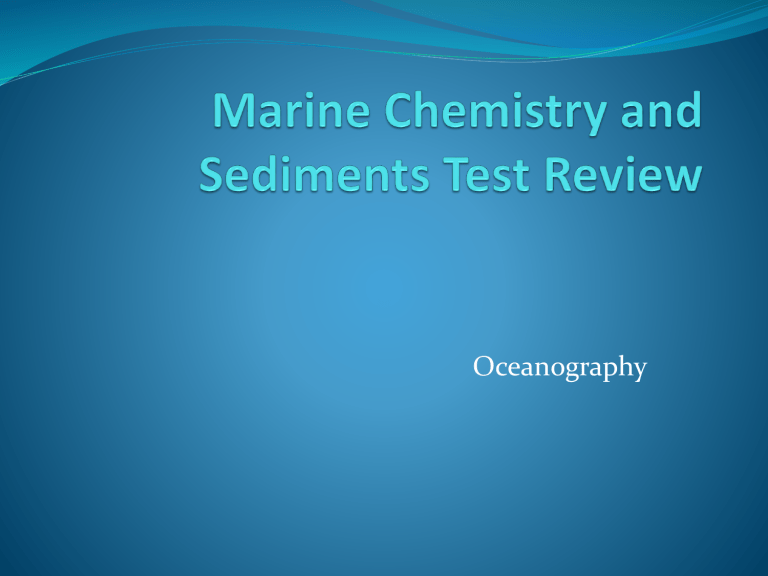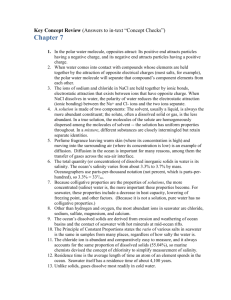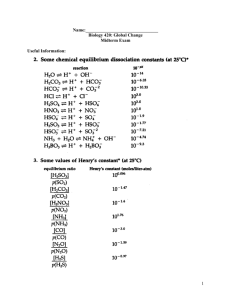Marine Chemistry and Sediments

Oceanography
What is the Forchhammer’s principle?
a.
The saturation level of seawater b.
The constant proportion of solids in seawater c.
The components of seawater from weathering surface rocks d.
The measure of the total mass of halogen ions
Georg Forchhammer realized that even though oceans may have varying salinity, dissolved solids are present in the ocean at constant proportions. He also observed that there was less silica and calcium in the ocean than in river water. These compounds are removed by marine organisms. Information can be found in the section Understanding the Ocean Began with Voyaging for
Trade and Exploration.
What is a solute?
a) b) c)
A substance, usually a liquid, which dissolves other substances
A substance that dissolves into another substance
A mixture of two or more substances
A polar molecule d)
In solutions, the solute is usually a dissolved solid or gas. Generally, the concentration of a solute in a solution is less abundant than the solvent. Information can be found in the section Water Is a Powerful
Solvent.
What is not true of a mixture?
a) b)
A mixture is different substances closely intermingled.
A mixture is able to maintain separate properties.
c) d)
A mixture is able to disperse homogenously.
A mixture may have varying concentrations and properties throughout.
A solution is heterogenously dispersed. The substances in a mixture are not as evenly distributed and keep their separate identities. Information can be found in the section Water Is a Powerful Solvent.
What causes a decrease in oxygen levels beyond the sunlit layer?
a) b) c)
The respiration from marine animals and bacteria
The by-products of photosynthesis
There are fewer animals present d) None of these choices
The high level of oxygen at the surface is the byproducts of photosynthesis. Beyond that layer, the oxygen decreases due to the respiration of marine animals. At deep depths, oxygen levels increase slightly because there are fewer animals at those depths. Information can be found in the section
Gases Dissolve in Seawater.
What is not a factor on the salinity of a particular region of ocean?
a) b) c) d)
Evaporation
Precipitation
Freshwater run-off from the continents
Saturation levels
Salinity is the concentration of dissolved inorganic solids in water. Despite an average of 35 0 /
00 salinity in the ocean, there are regions of variation. Salinity levels can be heavily impacted by evaporation, precipitation, and run-off activities. Information can be found in the section Seawater Consists of Water and Dissolved
Solids.
What type of water mass dissolves the most amounts of gases?
a) b) c) d)
Tropical water masses
Temperate water masses
Equatorial water masses
Polar water masses
Gases dissolve the most in colder waters. The saturation level increases as temperatures decrease. This partly explains the high nutrient productivity in the polar regions. Information can be found in the section Gases Dissolve in Seawater.
What is the average length of time an atom spends in the ocean?
a) b) c) d)
Longevity
Saturation time
Residence time
Durability time
Residence time explains why the ocean does not become progressively saltier with age. The residence time of an element can be calculated by dividing the amount of an element in the ocean by the rate at which the element is added or removed from the ocean. Information can be found in the section
Seawater Consists of Water and Dissolved Solids.
What enhances the ocean’s buffering capacity?
a) b) c) d)
The amount of dissolved inorganic carbon present
The amount of acid already present in the ocean
The amount of dissolved organic compounds
None of these choices
The ocean has a higher buffering capacity than rivers and lakes. This is due to the amount of dissolved inorganic carbon found in the ocean. This makes the ocean less prone to large pH swings when acids or bases are added whether it be from sewage outfalls or acid rain. Information can be found in the section The Ocean’s Acid-Base Balance
Varies with Dissolved Components and Depth.
What is the colligative property of osmotic pressure?
a) b) c) d)
The pressure exerted on biological membranes from the atmosphere
The pressure exerted on biological membranes from salinity differences outside the cells
The pressure exerted on biological membranes during temperature changes of water
The pressure exerted on biological membranes when surrounding waters phase change
Osmotic pressure rises with increasing salinity. This allows for the transmittance of water in and out of cells. Information can be found in the section
Seawater Consists of Water and Dissolved Solids.
What is the greatest source of oxygen in deep water?
a) b)
The respiration from bacteria
The lack of large quantities of organisms c) Chemosynthesis d) Polar waters that have sunk from the surface
Polar waters are very rich in nutrients, including oxygen. This water sinks from the surface in these regions and then circulated through deep water.
Information can be found in the section Gases
Dissolve in Seawater.
Water is able to dissolve ____ due to its polarity.
a) b) c) d) covalent bonds solvents ionic bonds
Solutions
Ionic bonds are held together by their electrostatic attraction between opposite charges.
Water’s polarity reduces this attraction until the ions are able to be separated. Information can be found in the section Water Is a Powerful Solvent.
What is the source of high carbon dioxide levels at middle depths in the ocean?
a) b) c)
The decay of the remains of organisms
It diffuses from the atmosphere
Chemical reactions d) Plant respiration
Carbon dioxide levels in the middle depths of the ocean are higher than they are at the surface.
Respiration from animals and the decay of the remains of organisms are the large contributors to these high levels of carbon dioxide. Information can be found in the section The Ocean’s Acid-Base Balance Varies with
Dissolved Components and Depth.
Which element would be surprisingly considered a trace element in the ocean despite its abundance in the atmosphere?
a) b) c) d)
Sodium
Calcium
Chloride
Nitrogen
Nitrogen is a trace element in the ocean despite its abundance in the atmosphere. Any element that is less than 1 part per million is considered a trace element.
Although trace elements are such small quantities, they are often crucial to life processes. Information can be found in the section Seawater Consists of Water and Dissolved
Solids.
What affects the residence time of an element?
a) b)
Its saturation level
Its chemical equilibrium in water c) Its chemical activity in water d) The principle of constant proportions
The residence time of an element is individual.
Some elements remain in seawater for short periods of time before becoming bound in sediments. Chemical activity of the element effects its residence time.
Information can be found in the section Seawater
Consists of Water and Dissolved Solids.
What is the source of most of the dissolved materials found in the ocean? a) b)
Outgassing
Convection currents
c) Dissolving and weathering of crustal rocks d) Biological activities
Although there are multiple sources of the dissolved materials in the ocean, much of the material comes from the weathering of surface rocks from rain and waves. The composition of the ocean is different from rivers because there is the addition of excess volatiles coming from the upper mantle. Information can be found in the section
Seawater Consists of Water and Dissolved Solids.
Which essential gas is often in an unusable form in the ocean and atmosphere?
a) b)
Nitrogen
Oxygen c) Carbon dioxide d) All of these choices
Nitrogen gas is saturates in the upper layers of the ocean. Although organisms need nitrogen to build proteins, most nitrogen cannot be used. The nitrogen needs to be bound or fixed in order to be used by organisms. Information can be found in the section Gases Dissolve in Seawater.
The level of ____ increases with depth which is a factor in the calcium carbonate compensation depth. a) Nitrogen b) Oxygen c) d)
Carbon Dioxide
Ammonia
Carbon dioxide concentrations are higher at deeper depths. Contrastingly, oxygen levels decrease as the depth decreases. This is true until middle depths of the ocean; then, oxygen levels begin to increase again.
Information can be found in the section Gases
Dissolve in Seawater.
How was salinity measured before the use of salinometers?
a) b) c)
Silver nitrate was used to measure the chlorinity
The mass of the salts were measured after water was evaporated
The conversion of sodium levels to salinity based on equations d) All of these choices
Marine chemists used silver nitrate to measure the chlorinity of a water sample. Equations were then used measure convert the chlorinity to the salinity of the sample. The procedure is calibrated against a known sample. Now salinometers are used by measuring the electrical conductivity. Information can be found in the section
Seawater Consists of Water and Dissolved Solids.
What happens to pH levels in regions where there is more carbon dioxide present?
a) b)
Carbon dioxide does not heavily impact pH levels
The pH levels increase in these regions.
c) d)
The pH levels decrease in these regions
The seawater is able to buffer enough that there is no change.
The pH level in the ocean can be altered in the ocean with changes in carbon dioxide. Higher levels of carbon dioxide which often occurs at middle depths in the ocean causes the water to be less alkaline. Information can be found in the section The Ocean’s Acid-Base Balance Varies with
Dissolved Components and Depth.
Why is the amount of carbon dioxide dissolved in seawater much less than the theoretical maximum saturation level?
a) Carbon dioxide is very soluble in water.
b) c)
Carbon dioxide is able to form a weak acid when combined with seawater.
Carbon dioxide is quickly used by photosynthetic organisms.
d) Carbon dioxide moves quickly from the atmosphere to the ocean.
Carbon dioxide chemically combines with water quite quickly which creates carbonic acid, but the low level in comparison to the theoretical maximum saturation level is due to photosynthetic organisms using it quickly.
Information can be found in the section Gases Dissolve in
Seawater.
Why does oil not dissolve in water?
a) b)
It has covalent bonds connecting the atoms.
It is found within tissues of organisms.
c) It is not a polar molecule.
d) It has ionic bonds.
Oil molecules are nonpolar. Nonpolar molecules are not attracted to water molecules so the bond strength found in oil is not diminished as it is with polar molecules. Information can be found in the section Water Is a Powerful Solvent.
What factor allows for the carbon present in sediments to re-enter back into atmospheric and oceanic cycles?
a) b)
Geological uplift
Acid rain c) Sediments dissolving d) All of these choices
Geological uplift can expose carbonate rock to chemical reactions with oxygen. Acid rain on limestone rock can release carbon dioxide. Lastly, sediments can also dissolve which would release the carbon dioxide that is stored in it. Information can be found in the section Gases Dissolve in Seawater.
What is the approximate mixing time of the ocean?
a) b)
160 years
1,600 years c) 16,000 years d) None of these choices
The mixing time of the ocean is due to vigorous current activity. This activity allows constituent materials to become evenly distributed throughout the ocean. Information can be found in the section
Seawater Consists of Water and Dissolved Solids.
What does carbon dioxide break down into once it is in the ocean?
a) b)
Carbonic acid
Bicarbonate c) Carbonate d) All of these choices
Carbon dioxide is able to form different compositions when dissolved in water. First, it creates carbonic acid, a weak acid. The acid then disassociates into bicarbonate and carbonate. Information can be found in the section The Ocean’s Acid-Base Balance Varies
with Dissolved Components and Depth.
What is the average pH of the ocean?
a) b)
7.0
7.5
c) d)
8.0
8.5
Although the pH can vary in particular regions and depths of the ocean, the average pH is 8.0. The amount of carbon dioxide can have large impacts on the pH levels. The range of pH found in the ocean is approximately 7.0 to 8.5. Information can be found in the section The Ocean’s Acid-Base Balance Varies with
Dissolved Components and Depth.
What is diffusion?
a) b)
The rate at which solute molecules present in a solution is equal to the rate they are being dissolved
The reforming of crystals c) The amount of substances tied to biological cycles d) The random movement of materials through a solution
Dissolved substances move randomly through a solution due to diffusion. These substances do, however, move from areas of high concentrations to areas of low concentrations.
Eventually, the result of diffusion is an evenly distributed, homogenous solution. Information can be found in the section Water Is a Powerful Solvent.
How do salinometers measure salinity?
a) b) c) d)
It measures the number of salt molecules in a set mass of seawater.
It calculates the salinity based on the density of the seawater.
It measures the electrical conductivity of seawater samples.
It calculates the salinity by measuring the chlorinity.
The conductivity of seawater varies with salt concentrations and temperatures. Salinometers are able to adjust for the water temperature and be calibrated against samples of known conductivity and salinity. Information can be found in the section
Seawater Consists of Water and Dissolved Solids.
Which item is not considered to have a basic pH?
a) b)
Seawater
Black coffee c) Household ammonia d) Baking soda
Many of the foods and liquids we consume are acidic. Black coffee and sodas are acidic. Seawater and the other items listed above are alkaline, or basic solutions. Information can be found in the section The Ocean’s Acid-Base Balance Varies with
Dissolved Components and Depth.
What is the term for ocean components not accounted for by the weathering of continents?
a) Conservative constituents b) Excess volatiles c) Nonconservative constituents d) Trace elements
Excess volatile are the components in the ocean that are not form the weathering of continents as the conservative constituents. These appear to be from the upper mantle. Information can be found in the section
Seawater Consists of Water and Dissolved Solids.
Why are some tropical waters unable to sustain life?
a) b) c)
There is an addition of pollutants in many of these areas.
There is a low level of dissolved oxygen due to temperature.
There is a greater amount of carbon dioxide.
d) There are more conservative components in these waters.
Gases dissolve readily in cold waters. Tropical waters have lower saturation capabilities. The oxygen concentrations in some tropical regions may not be able to sustain animals.
This can be further affected by the addition of pollutants from sewage. Information can be found in the section
Gases Dissolve in Seawater.






